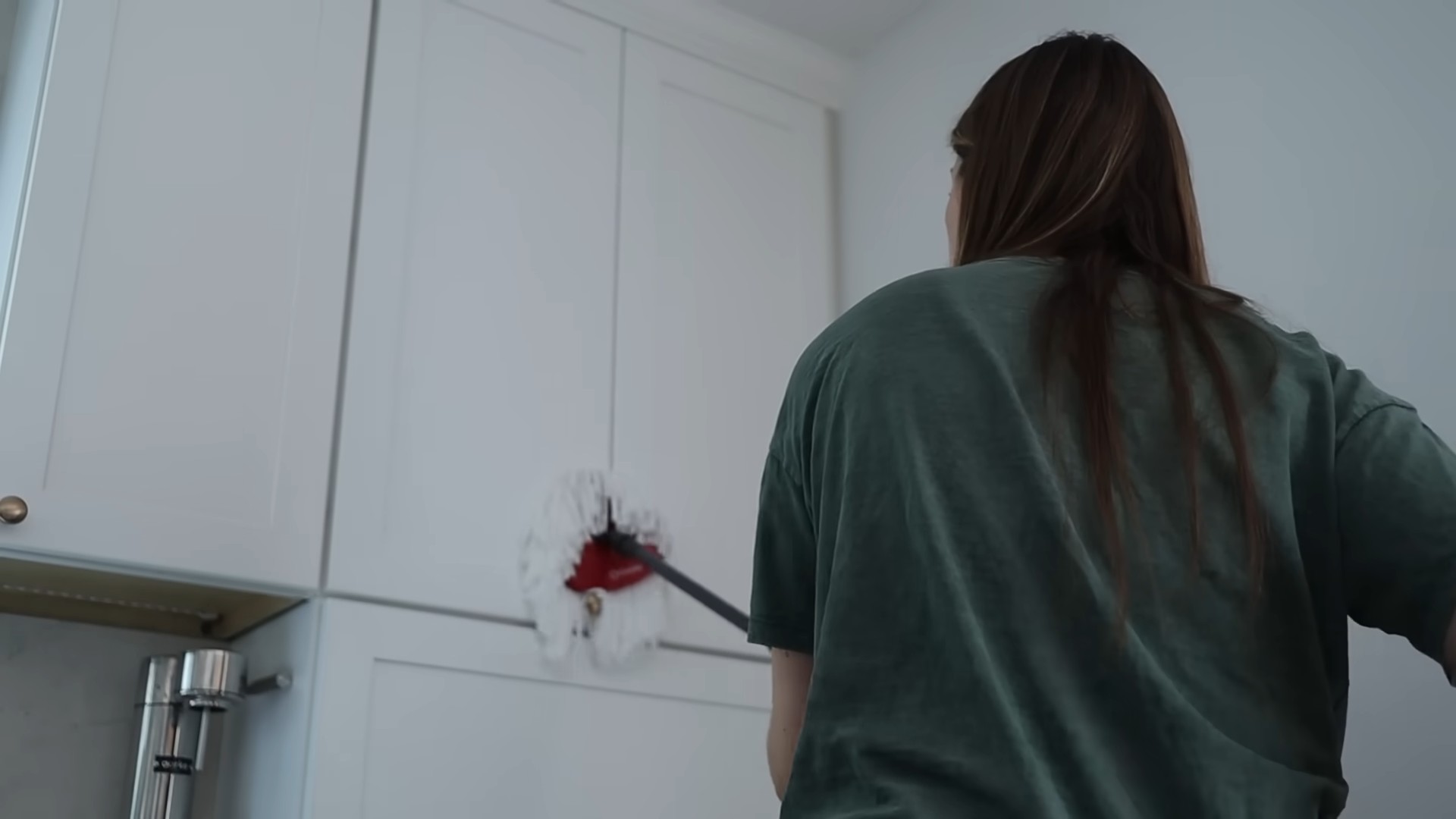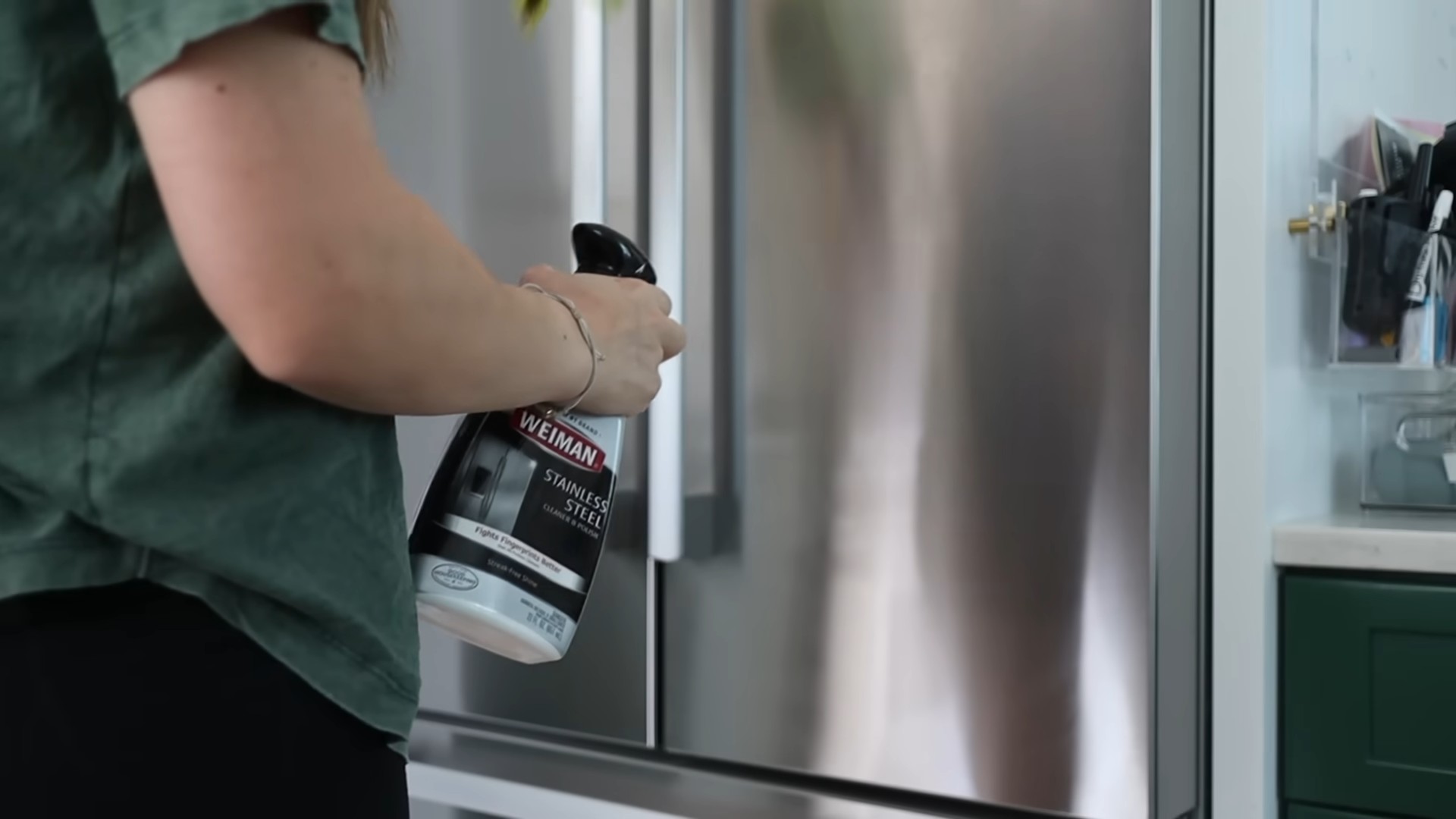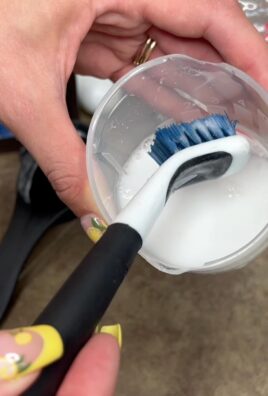Kitchen cleaning hacks – who doesn’t need a few of those up their sleeve? Let’s be honest, the kitchen, the heart of our homes, often bears the brunt of daily life. From splattered sauces to lingering odors, it can quickly transform from a culinary haven into a cleaning battlefield. But fear not, fellow home enthusiasts! I’m here to share some game-changing DIY tricks that will revolutionize your kitchen cleaning routine, saving you time, money, and a whole lot of elbow grease.
For centuries, resourceful homemakers have passed down cleaning wisdom, often relying on natural ingredients and clever techniques. Think about it – our grandmothers didn’t have a plethora of specialized cleaning products; they used what they had on hand, like vinegar and baking soda, to keep their kitchens sparkling. These time-tested methods are not only effective but also eco-friendly, a win-win in my book!
In today’s fast-paced world, we’re all looking for ways to simplify our lives. Spending hours scrubbing stubborn stains or battling greasy build-up is simply not an option. That’s where these kitchen cleaning hacks come in. I’ll show you how to tackle common kitchen cleaning challenges with easy-to-find ingredients and simple DIY solutions. Get ready to reclaim your kitchen and enjoy a cleaner, healthier, and more inviting space – without breaking the bank or sacrificing your precious time!

DIY Kitchen Cleaning Hacks: Sparkling Clean with Minimal Effort!
Hey there, fellow home enthusiasts! Let’s face it, the kitchen is the heart of the home, but it’s also a magnet for messes. From splattered sauces to greasy countertops, keeping it clean can feel like a never-ending battle. But fear not! I’m here to share some of my favorite DIY kitchen cleaning hacks that will leave your space sparkling without breaking the bank or spending hours scrubbing. Get ready to transform your kitchen into a pristine paradise!
Hack 1: The Magic of Baking Soda and Vinegar
This dynamic duo is a powerhouse when it comes to tackling tough kitchen messes. Baking soda is a gentle abrasive and deodorizer, while vinegar is a natural disinfectant and grease cutter. Together, they create a fizzing action that loosens grime and makes cleaning a breeze.
Cleaning a Greasy Oven
A dirty oven can be a real eyesore and affect the taste of your food. Here’s how to clean it naturally:
1. Remove Oven Racks: Take out the oven racks and soak them in hot, soapy water. You can add a cup of vinegar to the water for extra degreasing power. Let them soak while you work on the oven interior.
2. Baking Soda Paste: In a bowl, mix 1/2 cup of baking soda with enough water to form a thick paste. The consistency should be spreadable but not too runny.
3. Coat the Oven: Spread the baking soda paste all over the interior surfaces of your oven, avoiding the heating elements. Be generous with the application, especially on areas with baked-on grease.
4. Let it Sit Overnight: This is the key! Allow the baking soda paste to sit for at least 12 hours, or preferably overnight. This gives it time to penetrate and loosen the grime.
5. Vinegar Spray: The next day, fill a spray bottle with white vinegar. Spray the vinegar all over the baking soda paste. It will fizz and bubble – that’s a good sign!
6. Wipe Clean: Use a damp cloth or sponge to wipe away the baking soda and vinegar mixture. You may need to scrub a bit in stubborn areas.
7. Rinse and Dry: Rinse the oven interior with clean water to remove any remaining residue. Dry with a clean towel.
8. Clean the Racks: Scrub the oven racks with a sponge or brush to remove any remaining grease and grime. Rinse thoroughly and dry before placing them back in the oven.
Unclogging a Drain
A clogged drain can be a major inconvenience. This simple trick can often clear it without harsh chemicals:
1. Pour Boiling Water: Start by pouring a kettle of boiling water down the drain. This can sometimes dislodge minor blockages.
2. Baking Soda and Vinegar: Pour about 1/2 cup of baking soda down the drain, followed by 1 cup of white vinegar.
3. Let it Fizz: Let the mixture fizz for about 30 minutes. The fizzing action helps to break down grease and debris.
4. Flush with Boiling Water: After 30 minutes, flush the drain with another kettle of boiling water.
5. Repeat if Necessary: If the drain is still clogged, repeat the process. For stubborn clogs, you may need to use a plunger or a drain snake.
Hack 2: Lemon Power for a Fresh Kitchen
Lemons are not just for lemonade! Their natural acidity makes them excellent for cleaning and deodorizing. Plus, they leave behind a fresh, citrusy scent.
Cleaning a Microwave
Microwaves can quickly become splattered with food. This lemon steam cleaning method is quick and easy:
1. Lemon Water Solution: Fill a microwave-safe bowl with 1 cup of water and add the juice of one lemon (or several lemon slices).
2. Microwave for 3-5 Minutes: Place the bowl in the microwave and heat on high for 3-5 minutes, or until the water boils and the microwave is filled with steam.
3. Let it Sit: Leave the door closed for another 5 minutes to allow the steam to loosen the grime.
4. Wipe Clean: Carefully remove the bowl (it will be hot!) and wipe down the interior of the microwave with a damp cloth or sponge. The loosened food should come off easily.
Shining Stainless Steel
Lemon juice can also help to remove water spots and fingerprints from stainless steel appliances:
1. Lemon Juice Application: Cut a lemon in half and rub the cut side directly onto the stainless steel surface.
2. Wipe with a Damp Cloth: Use a damp cloth to wipe away the lemon juice.
3. Buff with a Dry Cloth: Buff the surface with a clean, dry cloth to remove any streaks and leave a shiny finish.
Hack 3: Coffee Grounds for a Clean Sink and Disposal
Don’t toss those used coffee grounds! They can be surprisingly useful for cleaning your kitchen.
Cleaning and Deodorizing the Garbage Disposal
Coffee grounds can help to scrub away buildup and neutralize odors in your garbage disposal:
1. Grind Coffee Grounds: Run cold water into the disposal while slowly pouring in about 1/2 cup of used coffee grounds.
2. Run Disposal: Turn on the garbage disposal for about 30 seconds. The coffee grounds will help to scrub the sides of the disposal and dislodge any trapped food particles.
3. Flush with Water: Flush the disposal with plenty of cold water to rinse away the coffee grounds and any debris.
Scrubbing the Sink
Coffee grounds can also be used as a gentle abrasive to clean your sink:
1. Sprinkle Coffee Grounds: Sprinkle a small amount of used coffee grounds into your sink.
2. Scrub with a Sponge: Use a damp sponge or cloth to scrub the sink, paying attention to any stains or buildup.
3. Rinse Thoroughly: Rinse the sink thoroughly with water to remove all traces of coffee grounds.
Important Note: Avoid using coffee grounds in your disposal if you have old or fragile pipes, as they can potentially cause clogs.
Hack 4: Dish Soap: The All-Purpose Cleaner
Good old dish soap is a versatile cleaner that can be used for more than just washing dishes.
Cleaning Countertops
Dish soap is effective for cleaning most countertop surfaces, including granite, quartz, and laminate:
1. Soapy Water Solution: Mix a few drops of dish soap with warm water in a spray bottle or bucket.
2. Spray and Wipe: Spray the solution onto the countertop surface and wipe with a damp cloth or sponge.
3. Rinse and Dry: Rinse the countertop with clean water and dry with a clean towel.
Cleaning Cabinets
Grease and grime can accumulate on kitchen cabinets over time. Dish soap can help to remove these deposits:
1. Soapy Water Solution: Mix a few drops of dish soap with warm water in a bucket.
2. Wipe with a Damp Cloth: Dip a clean cloth into the soapy water and wring out the excess. Wipe down the cabinet surfaces, paying attention to areas with grease or grime.
3. Rinse with a Clean Cloth: Rinse the cabinets with a clean, damp cloth to remove any soap residue.
4. Dry with a Clean Towel: Dry the cabinets with a clean towel to prevent water spots.
Hack 5: Hydrogen Peroxide: The Stain Remover
Hydrogen peroxide is a mild disinfectant and bleaching agent that can be used to remove stains from various surfaces.
Removing Stains from Cutting Boards
Cutting boards can easily become stained with food residue. Hydrogen peroxide can help to lighten or remove these stains:
1. Apply Hydrogen Peroxide: Pour hydrogen peroxide (3% solution) directly onto the stained area of the cutting board.
2. Let it Sit: Let the hydrogen peroxide sit for about 5-10 minutes.
3. Scrub and Rinse: Scrub the cutting board with a brush or sponge and then rinse thoroughly with water.
Cleaning Grout
Grout can become discolored and stained over time. Hydrogen peroxide can help to brighten and clean grout lines:
1. Apply Hydrogen Peroxide: Pour hydrogen peroxide (3% solution) directly onto the grout lines.
2. Let it Sit: Let the hydrogen peroxide sit for about 10-15 minutes.
3. Scrub with a Brush: Scrub the grout lines with a grout brush or an old toothbrush.
4. Rinse Thoroughly: Rinse the area thoroughly with water.
Important Note: Always test hydrogen peroxide in an inconspicuous area before applying it to a larger surface, as it can potentially bleach some materials.
Hack 6: Steam Cleaning for a Deep Clean
A steam cleaner can be a valuable tool for deep cleaning your kitchen without the use of harsh chemicals.
Cleaning Floors
Steam cleaning

Conclusion
So, there you have it! These kitchen cleaning hacks aren’t just about tidying up; they’re about reclaiming your time, saving money, and creating a healthier, more enjoyable cooking space. We’ve explored simple, effective solutions using ingredients you likely already have in your pantry. From banishing stubborn grease to reviving tired appliances, these DIY methods offer a powerful alternative to harsh chemicals and expensive cleaning products.
But why is this a must-try? Because it’s empowering! You’re taking control of your cleaning routine, understanding exactly what’s going into your cleaning solutions, and minimizing your environmental impact. Plus, the satisfaction of seeing a sparkling clean kitchen achieved with your own ingenuity is truly rewarding.
Don’t be afraid to experiment and adapt these kitchen cleaning hacks to your specific needs. For instance, if you’re dealing with particularly tough oven grime, try adding a bit of borax to your baking soda paste for extra cleaning power. Or, if you prefer a different scent, infuse your vinegar solution with citrus peels or essential oils. The possibilities are endless!
Consider these variations:
* **Lemon Power:** For a refreshing twist, use lemon juice instead of vinegar for cleaning cutting boards and countertops. The citric acid is a natural disinfectant and leaves behind a pleasant scent.
* **Essential Oil Boost:** Add a few drops of your favorite essential oil (like tea tree, lavender, or eucalyptus) to your cleaning solutions for added antibacterial and aromatherapy benefits.
* **Spice it Up:** For stubborn stains on stainless steel, try a paste of baking soda and a pinch of cinnamon. The cinnamon adds a gentle abrasive quality and a warm, inviting aroma.
* **DIY Dish Soap:** Combine castile soap, water, and a few drops of essential oil for a natural and effective dish soap alternative.
We genuinely believe that incorporating these kitchen cleaning hacks into your routine will transform your cleaning experience. It’s not just about cleaning; it’s about creating a more sustainable, healthier, and happier home.
Now, it’s your turn! We encourage you to try these DIY tricks and share your experiences with us. What worked best for you? Did you discover any new variations or combinations? Let us know in the comments below! We’re eager to hear your stories and learn from your successes. Together, we can create a community of savvy, eco-conscious cleaners who are passionate about keeping their kitchens sparkling without breaking the bank or harming the environment. Embrace the power of DIY and unlock the secrets to a truly clean and healthy kitchen.
Frequently Asked Questions (FAQ)
1. Are these kitchen cleaning hacks safe for all surfaces?
While most of these hacks are gentle and safe for a wide range of surfaces, it’s always a good idea to test them in an inconspicuous area first, especially on delicate materials like marble, granite, or painted surfaces. Vinegar, in particular, can be acidic and may etch certain types of stone. Baking soda is generally safe, but avoid using it on polished surfaces as it can be mildly abrasive. When in doubt, consult the manufacturer’s instructions for your specific surfaces.
2. How often should I use these kitchen cleaning hacks?
The frequency depends on your cleaning habits and the level of grime in your kitchen. For daily maintenance, wiping down countertops with a vinegar solution or cleaning cutting boards with lemon juice is perfectly fine. For deeper cleaning tasks like oven cleaning or descaling appliances, aim for once a month or as needed. Regular use of these hacks can prevent buildup and make cleaning easier in the long run.
3. Can I use these kitchen cleaning hacks if I have allergies or sensitivities?
If you have allergies or sensitivities, it’s crucial to be cautious when using any cleaning product, even natural ones. Always read the ingredients carefully and perform a patch test on a small area of skin before using the solution on a larger surface. Consider wearing gloves and a mask to minimize exposure to potential allergens. If you experience any adverse reactions, discontinue use immediately and consult with a healthcare professional. You can also tailor the recipes to avoid ingredients you know you’re sensitive to. For example, if you’re allergic to citrus, avoid using lemon juice and opt for a different cleaning agent like baking soda or vinegar.
4. How do I store homemade cleaning solutions?
Store your homemade cleaning solutions in clean, labeled spray bottles or containers. Clearly label each container with the contents and date of preparation to avoid confusion. Keep them out of reach of children and pets. Store solutions containing vinegar in plastic or glass containers, as vinegar can react with metal. Most homemade cleaning solutions have a shelf life of several weeks to a few months. If you notice any changes in color, odor, or consistency, discard the solution and make a fresh batch.
5. Are these kitchen cleaning hacks as effective as commercial cleaning products?
In many cases, yes! These kitchen cleaning hacks can be just as effective as commercial cleaning products, especially for everyday cleaning tasks. Vinegar, baking soda, and lemon juice are all powerful natural cleaners that can effectively remove grease, grime, and stains. However, for heavily soiled or specialized cleaning tasks, you may still need to use commercial products. The key is to use the right cleaning agent for the specific task and to allow sufficient contact time for the solution to work.
6. What are some other uses for baking soda in the kitchen?
Baking soda is a versatile ingredient with numerous uses beyond cleaning. It can be used to deodorize your refrigerator, remove stains from coffee mugs, unclog drains, and even tenderize meat. It’s also a key ingredient in many baking recipes. Keep a box of baking soda in your kitchen for all your cleaning and cooking needs.
7. How can I make my kitchen cleaning routine more sustainable?
There are many ways to make your kitchen cleaning routine more sustainable. In addition to using DIY cleaning solutions, consider using reusable cleaning cloths instead of paper towels, purchasing cleaning products in bulk to reduce packaging waste, and composting food scraps to reduce landfill waste. You can also choose cleaning products that are biodegradable and made with plant-based ingredients. By making small changes to your cleaning habits, you can significantly reduce your environmental impact.
8. What is the best way to clean a greasy stovetop?
A greasy stovetop can be a challenge to clean, but with the right approach, it’s manageable. Start by wiping up any loose debris with a paper towel. Then, sprinkle baking soda over the greasy areas and spray with vinegar. Let the mixture fizz for a few minutes, then scrub with a sponge or cloth. For stubborn grease, you may need to repeat the process or use a stronger cleaning agent like dish soap. Rinse the stovetop with water and dry with a clean cloth.
9. How do I get rid of odors in my kitchen?
Kitchen odors can be caused by a variety of factors, including food spills, garbage, and dirty appliances. To get rid of odors, start by identifying the source and cleaning it thoroughly. You can also place a bowl of baking soda in your refrigerator or freezer to absorb odors. Simmering a pot of water with cinnamon sticks or citrus peels can also help to freshen the air. Regularly emptying your garbage and cleaning your garbage disposal can also prevent odors from building up.
10. Can I use these cleaning hacks on my kitchen appliances?
Yes, many of these cleaning hacks are safe and effective for cleaning kitchen appliances. Vinegar can be used to descale coffee makers and kettles, baking soda can be used to clean the inside of your refrigerator, and lemon juice can be used to polish stainless steel appliances. However, always consult the manufacturer’s instructions before cleaning any appliance, and avoid using abrasive cleaners on delicate surfaces.





Leave a Comment